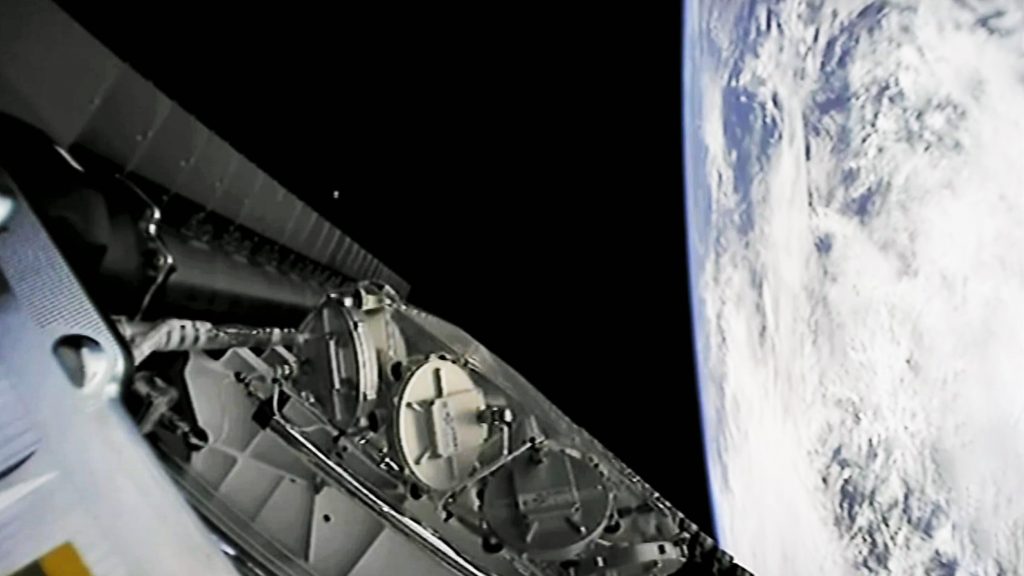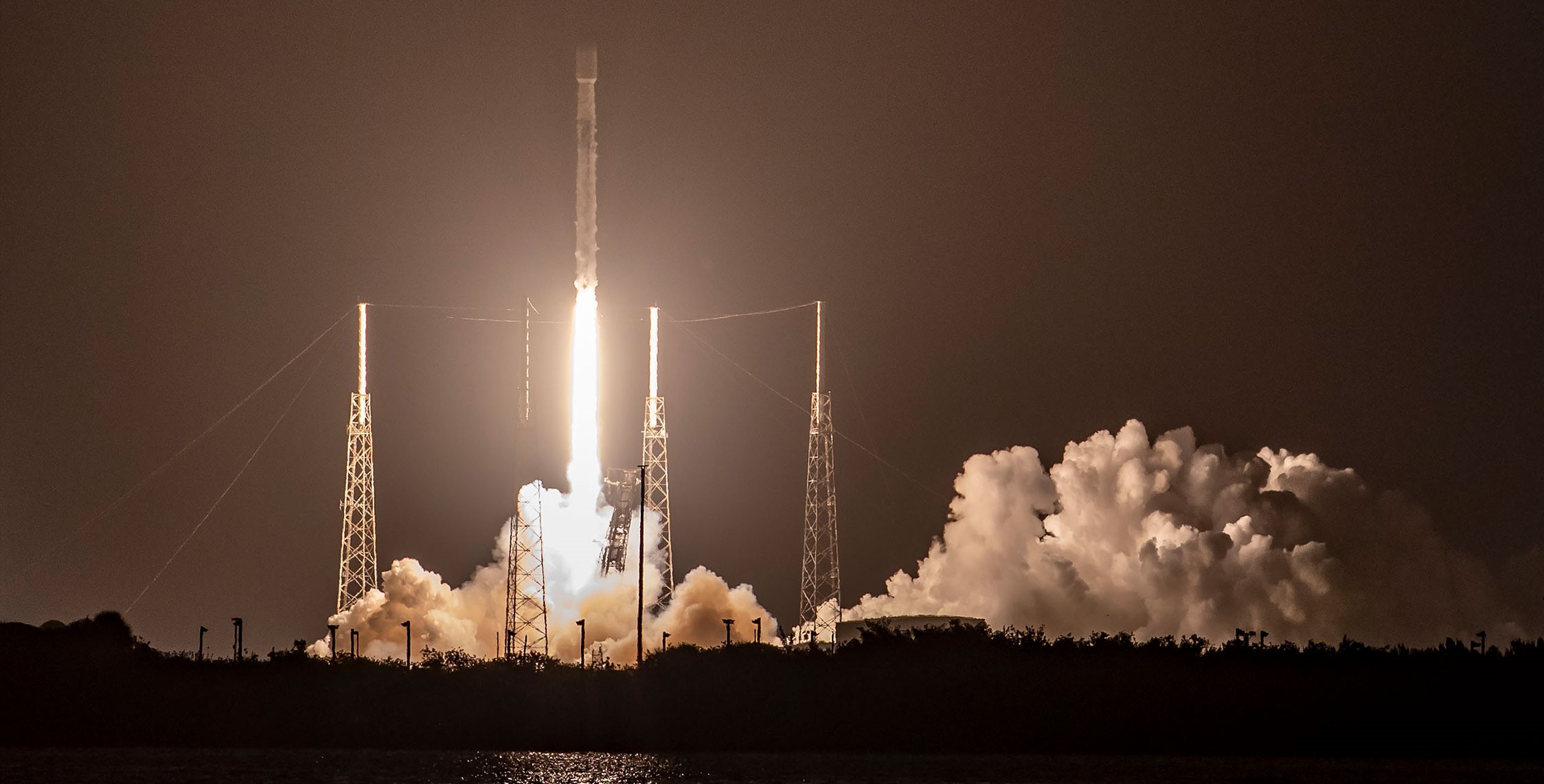SpaceX has set a new record for the heaviest payload launched on a Falcon 9 rocket as part of a routine Starlink satellite launch.
Simultaneously, the rocket responsible for setting that new record launched with a reusable booster that was last spotted clinging to life – engines heavily damaged – on the deck of a SpaceX drone ship eight months prior. At the time, it wasn’t clear if the Falcon 9 booster – theoretically capable of supporting at least 12-14 more launches – would be able to recover from the damage and fly again.
It’s now clear that the booster suffered no major invisible damage, ultimately allowing SpaceX to complete repairs and return the rocket to service at the cost of a lengthy delay.
According to spaceflight writer Alejandro Alcantarilla Romero, one additional cost – at minimum – was a full set of new Merlin 1D engines. Sometime shortly after Falcon 9 B1069’s flawless December 2021 launch and landing debut, a robotic helper known as Octagrabber most likely lost its grip on the booster while attempting to secure it. Likely already in high seas, the conditions prevented SpaceX workers from safely boarding the ship and manually securing the booster, which was then free to slide about its tilting deck.
Alternatively, it’s possible that Octagrabber successfully secured the booster but was then subjected to truly awful sea conditions. Designed to passively hold boosters to the deck with its sheer weight, even the tank-like robot wouldn’t be able to save a booster if a storm caught the drone ship off guard and the waves were high enough.

Either way, B1069 returned to port pressed against the lip of drone ship Just Read The Instructions’ (JRTI) deck, leaning hard to port. Worse, each of its nine fragile Merlin 1D engine nozzles had been crushed like tinfoil against Octagrabber, damaging them well beyond repair. While there’s a chance that SpaceX was or will be able to salvage the parts of B1069’s original M1D engines above their bell nozzles, it’s little surprise that the company had to fully replace those engines before the booster could fly again.
The damage B1069 suffered on its first launch makes it even more impressive that SpaceX attempted to break Falcon 9’s payload record with its return to flight, suggesting that the company was extremely confident in its repairs.


SpaceX confirmed that Falcon 9 broke the record with its launch of 54 Starlink V1.5 satellites at the end of its hosted webcast, revealing that the rocket launched 16.7 metric tons (~36,800 lb) to Low Earth Orbit (LEO). The last confirmed record – claimed by CEO Elon Musk – was 16.25 tons spread over 53 Starlink V1.5 satellites, which doesn’t entirely add up unless SpaceX added several kilograms to the mass of each satellite between March and August 2022.
Assuming that both numbers are comparable, a roughly 3% improvement is far from an earth-shaking or surprising step forward for SpaceX, a company, renowned for relentless iterative improvement. What is impressive, however, is that SpaceX pushed the envelope while Falcon 9 is both fast approaching its 150th consecutively successful launch and the only rocket currently certified to launch multiple NASA astronauts to the International Space Station. SpaceX’s fifth operational NASA astronaut launch (Crew-5) is scheduled as early as October 3rd. If SpaceX pushing the envelope on Starlink 4-23 had somehow caused the launch to fail, all Falcon 9 rockets would have likely been grounded for months, almost certainly delaying Crew-5 and throwing NASA’s ISS program into chaos.
Given how successful and reliable Falcon 9 already is, it would be hard to blame SpaceX if it decided to freeze the program and avoid additional changes, even if those changes could slightly improve the rocket’s performance. Instead, the company somehow manages to continue upgrading Falcon 9’s performance without obviously impacting its reliability or incurring the wrath of its strictest US government customers. Even Falcon landings, once considered a secondary objective that could be allowed to fail, haven’t suffered. Starlink 4-23 marked SpaceX’s 64th consecutively successful booster landing.
Up next, SpaceX is scheduled to launch Starlink 3-4 no earlier than (NET) August 31st, Starlink 4-20 NET September 4th, and Starlink 4-2 NET September 7th.
News
Tesla begins Robotaxi certification push in Arizona: report
Tesla seems serious about expanding its Robotaxi service to several states in the coming months.

Tesla has initiated discussions with Arizona transportation regulators to certify its driverless Robotaxi service in the state, as per a recent report from Bloomberg News. The move follows Tesla’s launch of its Robotaxi pilot program in Austin, Texas, as well as CEO Elon Musk’s recent comments about the service’s expansion in the Bay Area.
The Arizona Department of Transportation confirmed to Bloomberg that Tesla has reached out to begin the certification process for autonomous ride-sharing operations in the state. While details remain limited, the outreach suggests that Tesla is serious about expanding its driverless Robotaxi service to several territories in the coming months.
The Arizona development comes as Tesla prepares to expand its service area in Austin this weekend, as per CEO Elon Musk in a post on X. Musk also stated that Tesla is targeting the San Francisco Bay Area as its next major market, with a potential launch “in a month or two,” pending regulatory approvals.
Tesla first launched its autonomous ride-hailing program on June 22 in Austin with a small fleet of Model Y vehicles, accompanied by a Tesla employee in the passenger seat to monitor safety. While still classified as a test, Musk has said the program will expand to about 1,000 vehicles in the coming months. Tesla will later upgrade its Robotaxi fleet with the Cyercab, a two-seater that is designed without a steering wheel.
Sightings of Cybercab castings around the Giga Texas complex suggests that Tesla may be ramping the initial trial production of the self-driving two-seater. Tesla, for its part, has noted in the past that volume production of the Cybercab is expected to start sometime next year.
In California, Tesla has already applied for a transportation charter-party carrier permit from the state’s Public Utilities Commission. The company is reportedly taking a phased approach to operating in California, with the Robotaxi service starting with pre-arranged rides for employees in vehicles with safety drivers.
News
Tesla sets November 6 date for 2025 Annual Shareholder Meeting
The automaker announced the date on Thursday in a Form 8-K.

Tesla has scheduled its 2025 annual shareholder meeting for November 6, addressing investor concerns that the company was nearing a legal deadline to hold the event.
The automaker announced the date on Thursday in a Form 8-K submitted to the United States Securities and Exchange Commission (SEC). The company also listed a new proposal submission deadline of July 31 for items to be included in the proxy statement.
Tesla’s announcement followed calls from a group of 27 shareholders, including the leaders of large public pension funds, which urged Tesla’s board to formally set the meeting date, as noted in a report from The Wall Street Journal.
The group noted that under Texas law, where Tesla is now incorporated, companies must hold annual meetings within 13 months of the last one if requested by shareholders. Tesla’s previous annual shareholder meeting was held on June 13, 2024, which placed the July 13 deadline in focus.
Tesla originally stated in its 2024 annual report that it would file its proxy statement by the end of April. However, an amended filing on April 30 indicated that the Board of Directors had not yet finalized a meeting date, at least at the time.
The April filing also confirmed that Tesla’s board had formed a special committee to evaluate certain matters related to CEO Elon Musk’s compensation plan. Musk’s CEO performance award remains at the center of a lengthy legal dispute in Delaware, Tesla’s former state of incorporation.
Due to the aftermath of Musk’s legal dispute about his compensation plan in Delaware, he has not been paid for his work at Tesla for several years. Musk, for his part, has noted that he is more concerned about his voting stake in Tesla than his actual salary.
At last year’s annual meeting, TSLA shareholders voted to reapprove Elon Musk’s compensation plan and ratified Tesla’s decision to relocate its legal domicile from Delaware to Texas.
Elon Musk
Grok coming to Tesla vehicles next week “at the latest:” Elon Musk
Grok’s rollout to Tesla vehicles is expected to begin next week at the latest.

Elon Musk announced on Thursday that Grok, the large language model developed by his startup xAI, will soon be available in Tesla vehicles. Grok’s rollout to Tesla vehicles is expected to begin next week at the latest, further deepening the ties between the two Elon Musk-led companies.
Tesla–xAI synergy
Musk confirmed the news on X shortly after livestreaming the release of Grok 4, xAI’s latest large language model. “Grok is coming to Tesla vehicles very soon. Next week at the latest,” Musk wrote in a post on social media platform X.
During the livestream, Musk and several members of the xAI team highlighted several upgrades to Grok 4’s voice capabilities and performance metrics, positioning the LLM as competitive with top-tier models from OpenAI and Google.
The in-vehicle integration of Grok marks a new chapter in Tesla’s AI development. While Tesla has long relied on in-house systems for autonomous driving and energy optimization, Grok’s integration would introduce conversational AI directly into its vehicles’ user experience. This integration could potentially improve customer interaction inside Tesla vehicles.
xAI and Tesla’s collaborative footprint
Grok’s upcoming rollout to Tesla vehicles adds to a growing business relationship between Tesla and xAI. Earlier this year, Tesla disclosed that it generated $198.3 million in revenue from commercial, consulting, and support agreements with xAI, as noted in a report from Bloomberg News. A large portion of that amount, however, came from the sale of Megapack energy storage systems to the artificial intelligence startup.
In July 2023, Musk polled X users about whether Tesla should invest $5 billion in xAI. While no formal investment has been made so far, 68% of poll participants voted yes, and Musk has since stated that the idea would be discussed with Tesla’s board.
-

 Elon Musk1 week ago
Elon Musk1 week agoTesla investors will be shocked by Jim Cramer’s latest assessment
-

 Elon Musk3 days ago
Elon Musk3 days agoElon Musk confirms Grok 4 launch on July 9 with livestream event
-

 Elon Musk14 hours ago
Elon Musk14 hours agoxAI launches Grok 4 with new $300/month SuperGrok Heavy subscription
-

 News7 days ago
News7 days agoTesla Model 3 ranks as the safest new car in Europe for 2025, per Euro NCAP tests
-

 Elon Musk2 weeks ago
Elon Musk2 weeks agoA Tesla just delivered itself to a customer autonomously, Elon Musk confirms
-

 Elon Musk1 week ago
Elon Musk1 week agoxAI’s Memphis data center receives air permit despite community criticism
-

 Elon Musk2 weeks ago
Elon Musk2 weeks agoTesla’s Omead Afshar, known as Elon Musk’s right-hand man, leaves company: reports
-

 News2 weeks ago
News2 weeks agoXiaomi CEO congratulates Tesla on first FSD delivery: “We have to continue learning!”


















